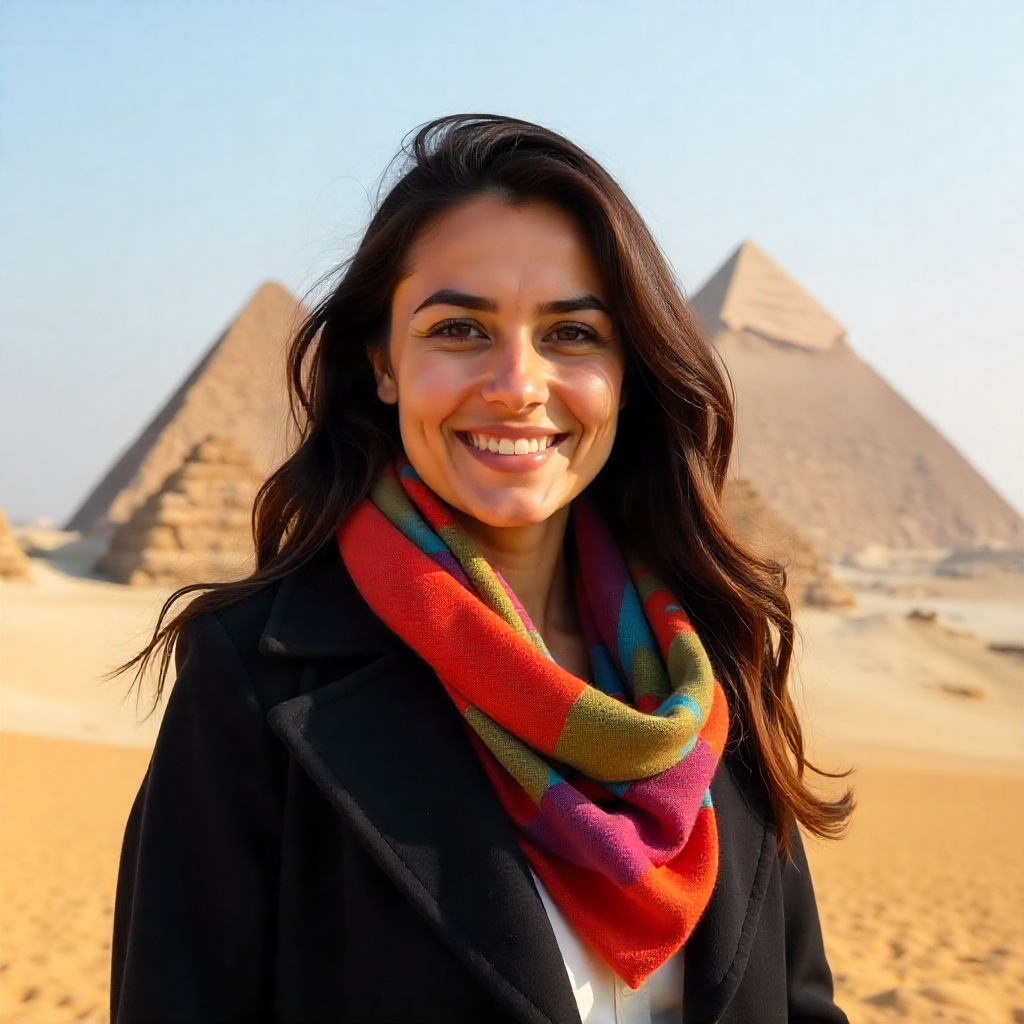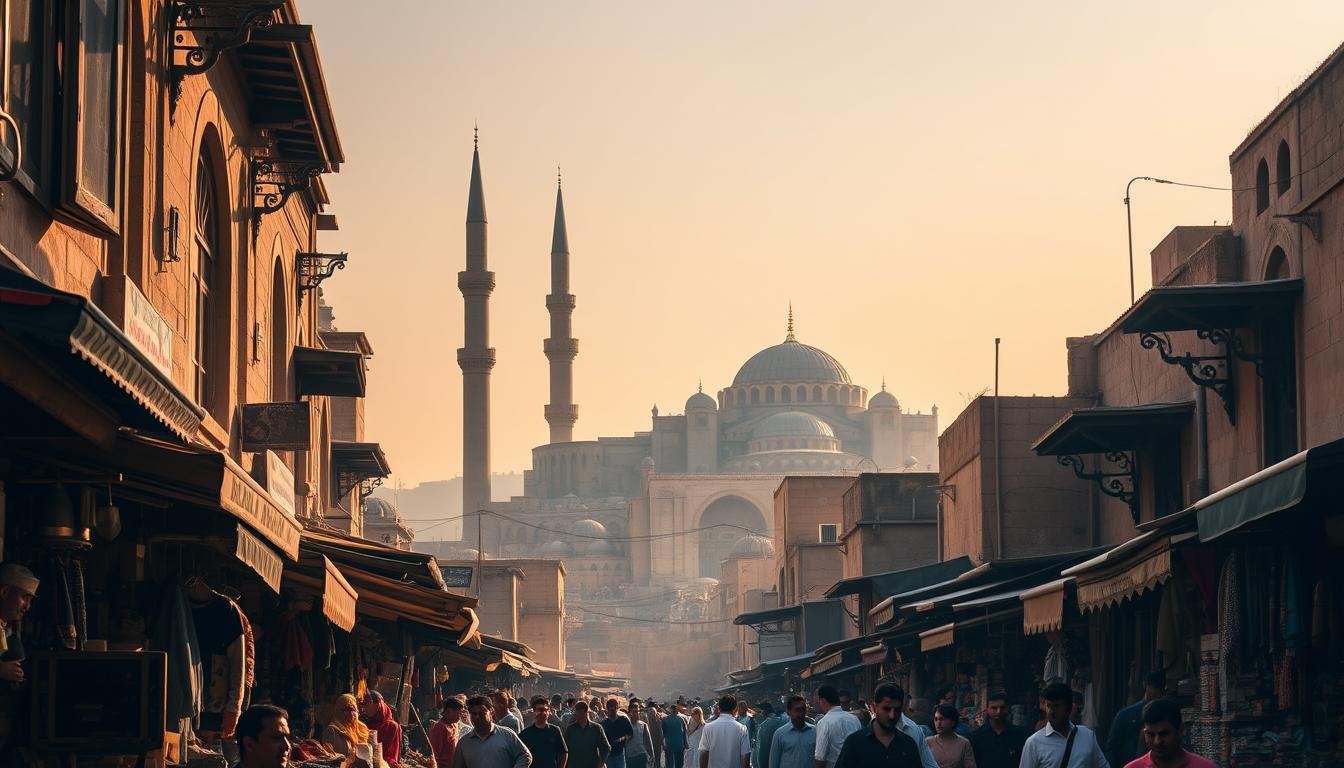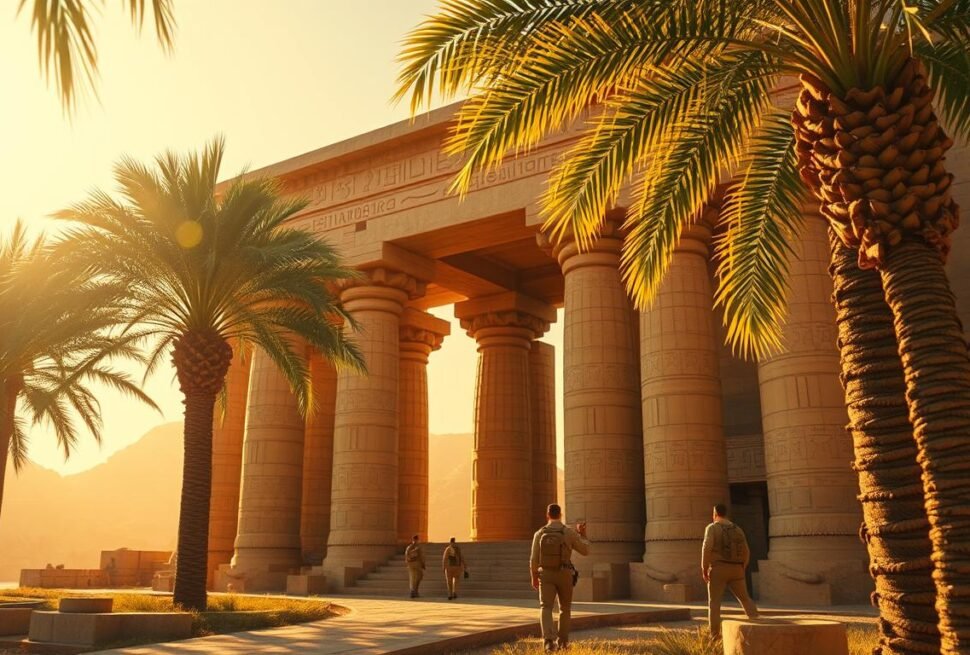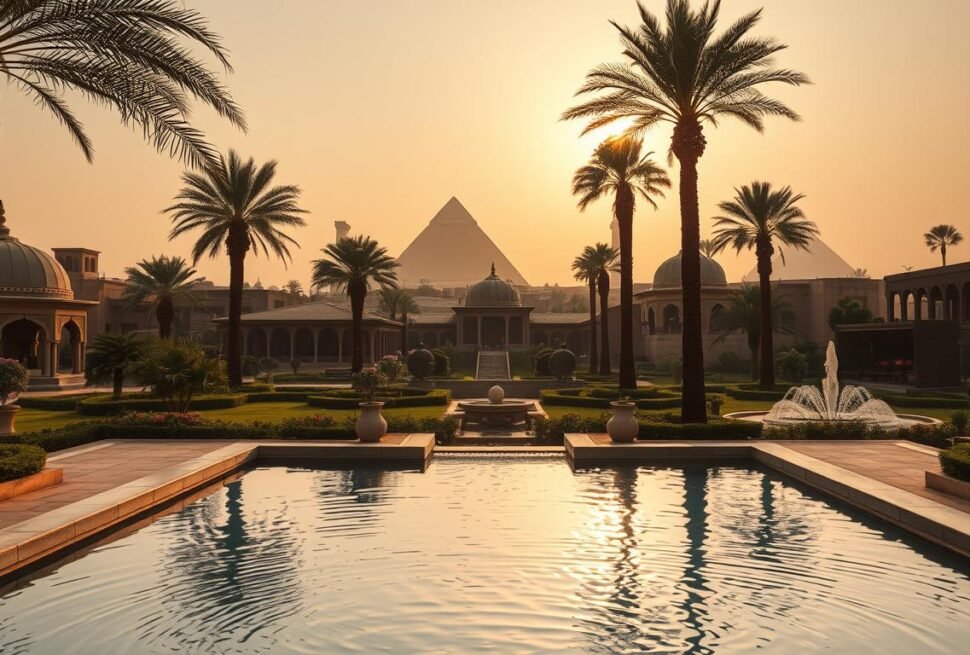Have you ever wondered what it feels like to walk through a living museum where every corner whispers stories from millennia past?
This ancient district offers an unparalleled journey through time. It’s a UNESCO World Heritage Site where pharaonic, Coptic, and Islamic heritage blend seamlessly. You’ll find yourself surrounded by architectural marvels and vibrant traditions.
The area boasts iconic landmarks like the stunning Hanging Church and the magnificent Ibn Tulun Mosque. The famous Khan el-Khalili market adds a bustling energy to the historic atmosphere. This guide will help you discover both well-known sites and hidden treasures.
Prepare to immerse yourself in centuries of rich history and authentic culture. You’ll gain practical insights for making the most of your visit to this extraordinary part of the city.
Key Takeaways
- Old Cairo is a UNESCO World Heritage Site blending ancient Egyptian, Coptic, and Islamic influences
- The area features remarkable landmarks including historic churches and mosques
- Khan el-Khalili offers an authentic marketplace experience
- This guide covers both famous attractions and lesser-known gems
- You’ll find practical tips for navigating and appreciating this historic district
- The neighborhood represents thousands of years of continuous history and culture
- Proper planning enhances your experience of this culturally rich destination
Your Ultimate Guide to Exploring Old Cairo: Mosques, Bazaars & Historic Streets
Imagine stepping into a neighborhood where time stands still, yet life pulses with vibrant energy. This district represents one of humanity’s most remarkable urban treasures.
Designated as a UNESCO World Heritage site in 1979, this area showcases exceptional medieval Islamic architecture. It’s one of the oldest continuously inhabited Islamic centers globally.
Why This Ancient District is a Must-See UNESCO World Heritage Site
The recognition came for outstanding preservation of cultural heritage. This world heritage site contains layers of history spanning centuries.
Key features that earned this status include:
- Africa’s oldest mosque (built 642 AD)
- The world’s second-oldest operating university
- Remarkably preserved medieval urban fabric
- Continuous Islamic civilization since the Middle Ages
The area maintains authentic character while functioning within modern urban life. This creates a unique living museum experience.
What to Expect on Your Journey Through Time
Your visit offers immersion into centuries of Islamic culture. The district reveals historical layers from Fatimid foundations through Mamluk and Ottoman periods.
You’ll encounter extraordinary landmarks including:
- Religious structures dating to the 7th century
- Ancient educational institutions still operating today
- Traditional markets maintaining centuries-old practices
- Architectural masterpieces from multiple dynasties
The Islamic Cairo experience feels like traveling through time. Every corner tells stories of civilizations that shaped this remarkable place.
Al-Azhar University, operating since 988 AD, represents continuous learning tradition. This institution highlights the area’s enduring cultural significance.
“The preservation of this medieval Islamic city offers unparalleled insight into historical urban development and cultural continuity.”
Prepare for an unforgettable journey through one of the world’s most historically rich urban environments. The experience combines ancient wonders with vibrant contemporary life.
Understanding the Rich Tapestry of Old Cairo’s History
What if you could peel back layers of time like pages in a history book? This district’s story spans over three millennia of continuous civilization.
Each era left its distinctive mark on the architecture and culture. You can literally walk through centuries of development in a single afternoon.
From Ancient Babylon to the Islamic Conquest
The area’s history dates back to Pharaonic times when it served as a strategic fortress. Pharaoh Ramses II established a settlement here around 1250 BC.
This ancient foundation became known as Babylon in Egypt. It stood as a vital military and trading post for centuries.
The Islamic conquest in 641 AD brought transformative changes. General Amr ibn al-As captured the region and immediately began building cultural landmarks.
He established Africa’s first mosque, which still operates today. This marked the beginning of Islamic influence that would shape the area’s future.
The Fatimid, Ayyubid, and Mamluk Eras
The Fatimid dynasty arrived in 969 AD and elevated the district to new heights. They established Al-Azhar University, creating a center of learning that continues today.
This period saw magnificent architectural projects and cultural flourishing. The Fatimids built impressive walls and gates that still define the area.
Saladin’s Ayyubid dynasty followed, adding robust fortifications. They constructed Bab al-Futuh (Gate of Conquest), which remains an impressive landmark.
The Mamluks took control around 1250 AD and continued building monuments. Their era produced some of the most stunning religious and educational structures.
“The historical layers here tell a complete story of urban development from ancient times through medieval periods.”
Each ruling power contributed to the rich architectural tapestry. You can see Roman foundations supporting Fatimid mosques and Mamluk madrasas.
Even Napoleon’s brief occupation in 1798 left subtle influences. This complex history creates the fascinating blend visible today.
| Historical Period | Time Frame | Key Contributions |
|---|---|---|
| Ancient Foundation | 1250 BC | Babylon fortress established by Ramses II |
| Islamic Conquest | 641 AD | Africa’s first mosque built by Amr ibn al-As |
| Fatimid Era | 969-1171 AD | Al-Azhar University and city walls constructed |
| Ayyubid Period | 1171-1250 AD | Fortifications including Bab al-Futuh gate |
| Mamluk Rule | 1250-1517 AD | Religious monuments and educational institutions |
This incredible continuity makes the area unique among world heritage sites. You’re walking through living history that still serves its original purposes.
The mosque built in the 7th century still welcomes worshippers today. The university founded over a thousand years ago still educates students.
This isn’t a museum frozen in time—it’s a living neighborhood with deep roots. Each century added another layer to this remarkable urban tapestry.
An Introduction to the Two Souls of Old Cairo: Coptic & Islamic
Have you considered how two distinct spiritual traditions created one remarkable neighborhood? This area beautifully blends Christian and Islamic histories in one captivating district.
These two communities have coexisted for centuries. Each maintains unique traditions while sharing the same urban space.
This creates a fascinating cultural tapestry. You’ll discover how different faiths built their spiritual homes side by side.
Coptic Cairo: A Center of Early Christianity
Coptic Christians have lived here since the 4th century AD. This area became their spiritual home during Roman times.
Important religious sites include the magnificent Hanging Church. It dates to the 7th century and sits on Roman fortress foundations.
Other significant locations include:
- Church of St. Sergius and Bacchus – where Holy Family reportedly stayed
- Ben Ezra Synagogue – important to Cairo’s Jewish community
- Coptic Museum – preserving early Christian artifacts
These places tell the story of Christianity’s early days in Egypt. They represent centuries of continuous worship and tradition.
Islamic Cairo: A Beacon of Medieval Islamic Civilization
The Fatimids established Islamic Cairo in 969 AD. It quickly became a center of culture and learning.
This area features magnificent mosques and madrasas. They showcase incredible Islamic art and architecture.
Different dynasties left their mark:
- Fatimid – city walls and early mosques
- Ayyubid – fortified gates and citadels
- Mamluk – elaborate religious schools
- Ottoman – refined architectural details
These structures form an incredible collection of Islamic cultural heritage. They remain active places of worship and education today.
| Area | Established | Key Features | Cultural Significance |
|---|---|---|---|
| Coptic Quarter | 4th Century AD | Ancient churches, synagogue, museum | Early Christian center and pilgrimage site |
| Islamic District | 969 AD | Mosques, madrasas, bazaars | Medieval Islamic learning and culture |
Both areas offer unique perspectives on Egypt’s rich spiritual history. They showcase how different communities built their sacred spaces.
This coexistence creates a special atmosphere. You can experience multiple layers of history in one visit.
These neighborhoods represent living cultural heritage. They continue to serve their original purposes while welcoming visitors.
Essential Planning: Before You Go to Old Cairo
Proper preparation transforms a good trip into an unforgettable experience. Smart planning helps you navigate cultural customs and maximize your enjoyment.
This section covers practical details for your visit. You’ll learn about ideal timing, appropriate attire, and transportation options.
Best Time of Year to Visit for Ideal Weather
October through April offers perfect conditions for exploring. Temperatures stay mild and comfortable for extended outdoor activities.
Summer months from May to September bring intense heat. The extreme temperatures can make extensive walking quite challenging.
Spring and autumn provide the most pleasant weather patterns. These seasons allow comfortable exploration of all outdoor attractions.
What to Wear: Respectful and Comfortable Attire
Dress modestly to respect local customs and religious sites. Shoulders and knees should remain covered at all times.
Women should carry a scarf for mosque visits. This shows respect for religious traditions and cultural norms.
Comfortable walking shoes are absolutely essential. You’ll navigate uneven surfaces and ancient pathways throughout your visit.
How to Get There: Metro, Taxi, and Walking Routes
The Cairo Metro Line 1 offers convenient access to Mar Girgis station. This provides easy entry to the main historical areas.
Taxis work well for direct transportation. Always negotiate fares beforehand to ensure fair pricing.
Walking from central areas allows gradual immersion into the atmosphere. This approach lets you experience the city’s unique character.
For personalized assistance, contact Black Camel Tours at +43 660 9081449 or +201080733101. Their local insights can enhance your planning process significantly.
Why a Guided Tour Enhances Your Old Cairo Experience
What if every turn through ancient pathways revealed stories only locals know? Professional guidance transforms simple sightseeing into deep cultural immersion.
The maze-like layout of this historic district challenges even experienced travelers. Having an expert navigator makes exploration both enjoyable and efficient.
Navigating the Labyrinthine Alleys with Ease
The narrow pathways wind through centuries of history. Without local knowledge, you might miss hidden courtyards and significant landmarks.
Expert guides know the most efficient routes between attractions. They help you avoid crowded areas during peak times.
You’ll discover shortcuts that save time and energy. This lets you focus on enjoying the sights rather than checking maps.
Gaining Deeper Insight into History and Culture
Professional interpreters explain architectural styles and historical contexts. They share stories that bring ancient stones to life.
You’ll understand cultural significance behind each monument. This transforms buildings from beautiful structures into meaningful landmarks.
Local experts explain customs and traditions at religious sites. This ensures respectful behavior while deepening your appreciation.
Ensuring Safety and Maximizing Your Time
Guides know which areas require extra caution. They keep you safe while maintaining an enjoyable atmosphere.
Time optimization means seeing more in less time. Pre-planned routes cover key sites without unnecessary backtracking.
You’ll receive recommendations for authentic dining and shopping. This eliminates guesswork and ensures quality experiences.
“A knowledgeable guide doesn’t just show you places—they help you understand the soul of the city and its people.”
| Independent Exploration | Guided Tour Experience |
|---|---|
| Self-navigation through complex pathways | Expert-led routing through optimized paths |
| Basic information from guidebooks | Rich storytelling and historical context |
| Potential safety concerns in unfamiliar areas | Local knowledge ensuring safe exploration |
| Time spent navigating and planning | Maximum site coverage in minimal time |
| Generic shopping and dining choices | Authentic local recommendations |
| Surface-level understanding of sites | Deep cultural and architectural insights |
Booking with Black Camel Tours ensures professional guidance from local experts. Their tours combine historical knowledge with practical navigation skills.
Contact them at Booking@blackcameltours.com or visit blackcameltours.com. They offer curated experiences that maximize your cultural immersion.
The right guide transforms your visit from ordinary to extraordinary. You’ll gain memories and understanding that last long after your journey ends.
Exploring the Wonders of Coptic Cairo
Have you ever walked through a neighborhood where ancient faiths still breathe life into every stone? This special quarter holds some of Egypt’s most sacred Christian landmarks.
These religious sites represent centuries of continuous worship. They showcase incredible artistry and deep spiritual significance.
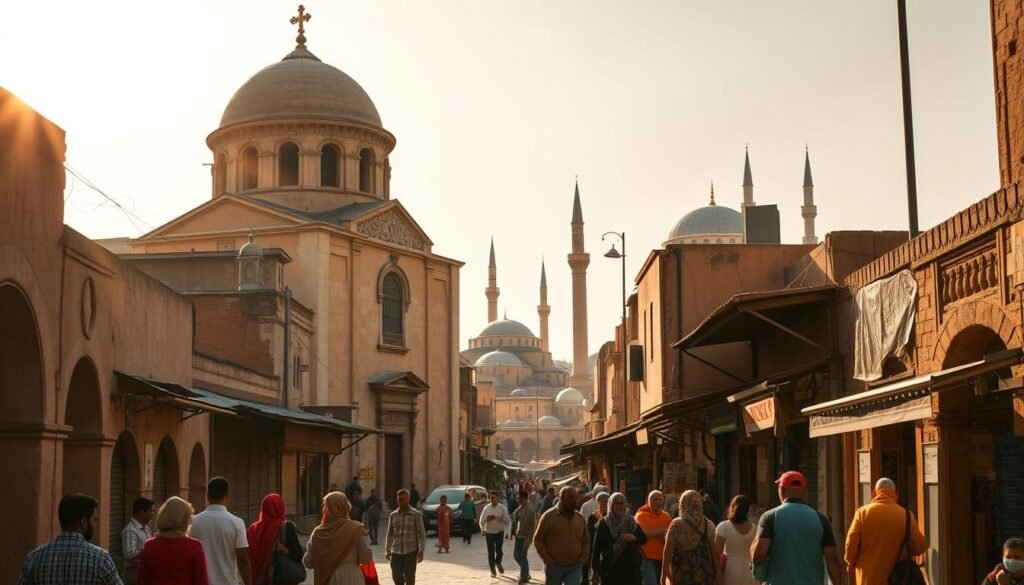
The Hanging Church (Al-Mu’allaqah)
The magnificent hanging church stands as a masterpiece of Coptic architecture. Built in the 7th century, it rests atop Roman fortress walls.
Inside, you’ll find beautiful frescoes and a stunning marble pulpit. The church feels suspended between heaven and earth.
This sacred space has served worshippers for over thirteen centuries. Its peaceful atmosphere invites quiet reflection.
The Coptic Museum and Its Ancient Treasures
The museum houses an incredible collection of Coptic art and artifacts. You’ll see ancient manuscripts, textiles, and woodwork.
Each piece tells part of the Coptic Christian story. The exhibits showcase remarkable craftsmanship through the ages.
This institution preserves vital cultural heritage for future generations. It offers deep insight into early Christian traditions.
Church of St. Sergius and Bacchus (Abu Serga)
This ancient church marks where the Holy Family found refuge in Egypt. Tradition says they stayed in the crypt below.
The underground chamber holds special significance for pilgrims. You can feel the weight of history in this sacred space.
The church architecture blends different historical periods. It represents continuous worship across many centuries.
Ben Ezra Synagogue and the Cairo Geniza
Originally a Christian church, this building became a synagogue in the 9th century. It holds an extraordinary historical discovery.
In the 19th century, researchers found the Cairo Geniza in the attic. This treasure contained medieval Jewish manuscripts.
The synagogue represents interfaith history in this unique district. It shows how different communities shared this sacred space.
“These ancient sites connect us to faith traditions that have endured through centuries of change and challenge.”
Each location offers unique perspectives on spiritual history. They remain active places of worship and pilgrimage today.
You’ll notice architectural blends of Coptic and Islamic styles. This reflects the area’s rich cultural interactions.
These sacred spaces welcome visitors seeking understanding and connection. They represent living history that continues to inspire.
Discovering the Architectural Marvels of Islamic Cairo
What if you could witness architectural genius that has inspired builders for centuries? The district contains some of the world’s most spectacular religious structures.
These buildings showcase incredible craftsmanship and spiritual devotion. Each tells a unique story of faith and cultural achievement.
You’ll encounter masterpieces from different Islamic dynasties. They represent the pinnacle of Islamic architecture through the ages.
Mosque of Ibn Tulun: One of Africa’s Oldest Mosques
The magnificent Ibn Tulun mosque stands as a timeless treasure. This ninth-century structure remains remarkably preserved.
Its unique spiral minaret draws inspiration from Samarra’s Great Mosque. The design creates a striking silhouette against the Cairo sky.
Inside, you’ll find one of Egypt’s largest mosque courtyards. Intricate stucco carvings adorn the arches and windows.
This space offers peaceful contemplation away from city bustle. The atmosphere transports visitors to another era.
Al-Azhar Mosque and the World’s Second-Oldest University
Al-Azhar represents continuous learning since its foundation. The mosque built in 969 AD houses an extraordinary institution.
It has operated as a university since 988 AD. This makes it the world’s second-oldest continuously running university.
The complex serves as a center for Islamic studies and culture. Students from across the globe come here to learn.
You’ll appreciate the beautiful prayer halls and courtyards. They blend spiritual purpose with educational function.
Sultan Hassan Mosque & Madrasa: A Mamluk Masterpiece
The Sultan Hassan mosque showcases Mamluk architectural brilliance. This fourteenth-century complex will leave you awestruck.
Its monumental entrance portal stands as an engineering marvel. The soaring minaret reaches toward the heavens.
Inside, the vast courtyard features intricate decorative details. The madrasa sections housed students studying Islamic sciences.
This site represents religious and educational excellence. It remains one of Cairo’s most impressive landmarks.
“These structures represent the highest achievements of Islamic architectural tradition, blending spiritual purpose with breathtaking artistry.”
Each mosque demonstrates distinct architectural evolution. You can see different dynastic influences in their designs.
These places remain active centers of worship and learning. They welcome visitors seeking beauty and understanding.
Your visit offers insight into Islamic cultural heritage. You’ll gain appreciation for these magnificent achievements.
A Stroll Down Historic Al-Muizz Al-Deen Allah Street
Picture yourself walking through an open-air gallery where every building tells a story. This famous street offers one of the world’s most impressive collections of Islamic architecture.
It runs through the heart of the ancient city. You’ll find incredible landmarks from different historical periods.
A Mile-Long Museum of Islamic Architecture
This thoroughfare stretches about one kilometer through the historic district. Many call it a “mile-long museum” for good reason.
Both sides feature continuous historical monuments. You’ll see the greatest concentration of medieval treasures anywhere.
The collection spans multiple Islamic dynasties. Each ruler added their own architectural masterpiece.
Key Monuments and Landmarks Along the Way
Your walk reveals amazing structures from different eras. The street connects two magnificent gates: Bab al-Futuh and Bab Zuweila.
Important sites include:
- Mosques from Fatimid, Mamluk, and Ottoman periods
- Ancient madrasas (Islamic schools) still operating today
- Beautiful mausoleums honoring important figures
- Historic gates that once protected the city
You can observe architectural evolution through successive structures. Each building shows different design influences.
The atmosphere blends history with modern daily life. Locals go about their business amidst these ancient treasures.
This street makes an excellent navigational landmark. Use it as your base for exploring surrounding areas.
Don’t forget your camera! The beautiful facades and details offer perfect photo opportunities.
Getting Lost in the Khan el-Khalili Bazaar
Have you ever wandered through a marketplace where centuries of commerce echo through every alleyway? The Khan el-Khalili offers an adventure unlike any other shopping experience.
This vibrant marketplace transports you back to medieval times. The air fills with aromatic scents and the sounds of friendly haggling.
A Shopping Experience Steeped in History
Established in 1382, this bazaar stands on historic ground. It was built where Fatimid rulers once buried their elite.
The market expanded during the 15th century as a major trade hub. Merchants once traded precious stones, exotic spices, and other valuable goods here.
Ornate gates still mark the market’s boundaries. These architectural features get locked each evening, preserving tradition.
Finding Authentic Souvenirs, Spices, and Lamps
You’ll discover wonderful traditional items throughout the market. Handcrafted lanterns create beautiful patterns when lit.
Colorful textiles showcase local weaving techniques. Intricate jewelry reflects Egypt’s rich artistic heritage.
The spice stalls offer aromatic blends that tease your senses. These exotic mixtures recall the market’s historical trade items.
Perfume vendors provide scents made from natural ingredients. These fragrances have been crafted using traditional methods for generations.
Tips for Navigating and Bargaining in the Souq
The market’s layout can feel confusing at first. Narrow pathways twist between shops in seemingly random patterns.
Bargaining remains an expected part of the shopping experience. Vendors often begin with higher prices anticipating negotiation.
Always maintain friendly conversation during price discussions. This respectful approach typically yields better results than aggressive haggling.
Take time to appreciate the historic architecture above the shops. Look up to see beautiful Islamic designs that frame the market experience.
“The market’s energy creates an unforgettable sensory journey—where every scent, sound, and sight tells a story of centuries-old commerce.”
| Market Feature | Historical Significance | Modern Experience |
|---|---|---|
| Architectural Gates | Original 14th century security features | Photogenic landmarks and meeting points |
| Spice Shops | Historical trade in exotic spices | Aromatic shopping and cultural experience |
| Handcraft Areas | Traditional artisan workshops | Authentic souvenir shopping opportunities |
| Alley Layout | Medieval urban planning design | Engaging exploration experience |
The market’s vibrant atmosphere makes every visit memorable. You’ll leave with unique treasures and lasting memories of this historic shopping adventure.
Visiting the Saladin Citadel and the Muhammad Ali Mosque
What if you could stand where sultans once surveyed their kingdom while admiring one of Islam’s most beautiful mosques? The Citadel complex offers this incredible combination of military history and religious artistry.
Perched high on Mokattam Hill, this fortress has watched over the city for centuries. It represents both defensive strength and spiritual devotion in one magnificent site.
The History of the Citadel’s Strategic Importance
Saladin ordered construction between 1176 and 1183 AD. He needed strong defenses against Crusader forces.
The location on Mokattam Hill provided natural protection. It offered clear sightlines approaching enemies.
This fortress served as Egypt’s administrative center for 700 years. Rulers from various dynasties made it their power base.
The Cairo Citadel witnessed countless historical events. It protected the city through many conflicts.
Panoramic Views of the Cairo Skyline
The elevated position creates breathtaking panoramic views. You can see across the entire metropolitan area.
The Cairo skyline unfolds like a living history book. Modern buildings blend with ancient minarets.
These vistas help understand the city’s layout and growth. You’ll appreciate why this location held such strategic value.
Exploring the Alabaster Mosque (Mohamed Ali Mosque)
The Muhammad Ali Mosque dominates the Citadel complex. This Ottoman-style masterpiece took 18 years to build.
Its gleaming alabaster façade creates a stunning visual impact. Soaring minarets reach toward the sky.
Inside, the opulent interior features intricate details. Massive domes and elegant lighting create a majestic atmosphere.
This mosque represents 19th-century architectural ambition. It remains one of Egypt’s most photographed landmarks.
“The Citadel represents both the sword and the soul of Cairo—where military might and spiritual devotion created an enduring landmark.”
Remember the Citadel is the larger fortress complex. The mosque is one structure within its walls.
You’ll also find other mosques and museums to explore. Each adds depth to this historically rich site.
This fortress has dominated the city’s horizon for centuries. Its continued presence speaks to its enduring importance.
Other Noteworthy Mosques and Landmarks
Beyond the main attractions, this historic district holds hidden gems that complete your cultural journey. These sites offer unique perspectives and quieter moments of discovery.
Each location tells a different part of the area’s rich story. They showcase diverse architectural styles and historical periods.
Amr Ibn Al-Aas Mosque: The First Mosque in Egypt
The Mosque of Amr ibn al-As represents a foundational moment in Egyptian history. This remarkable structure was built in 642 AD, making it Africa’s one oldest Islamic place of worship.
General Amr ibn al-As established this mosque after the Islamic conquest. It served as the central gathering place for early Muslims in Egypt.
The original structure was much simpler than today’s version. Multiple expansions and renovations have enhanced its design over centuries.
You’ll appreciate the peaceful courtyard and simple architectural lines. This space feels deeply connected to Islam’s early days in North Africa.
Al-Hakim Mosque: A Fatimid Era Gem
The Al-Hakim Mosque showcases Fatimid architectural ambition at its finest. Construction took place between 990 and 1012 AD under two caliphs.
This mosque stands as the second largest Fatimid religious structure. Its distinctive appearance features white brick construction and red stone minarets.
The minarets display unique design elements resembling ancient Egyptian pylons. This architectural blend creates a fascinating visual statement.
Recent restoration work has returned the mosque to its former glory. You can now appreciate its original grandeur and spiritual atmosphere.
Al-Azhar Park: A Green Oasis with Stunning Views
Al-Azhar Park offers a beautiful contrast to the historic urban landscape. This modern green space provides breathtaking views of the ancient city.
The park development transformed a former garbage dump into a beautiful oasis. It now serves as a popular retreat for locals and visitors alike.
Well-maintained pathways wind through gardens and past fountains. Several cafes offer perfect spots to relax while enjoying the panoramic views.
From the park’s elevated positions, you can see across Islamic Cairo’s skyline. The vista includes numerous minarets and historic buildings.
“These additional sites provide valuable context, showing how Islamic architecture evolved across different periods and rulers.”
Each location contributes something unique to your understanding:
- Amr ibn al-As Mosque – foundational Islamic history
- Al-Hakim Mosque – Fatimid architectural innovation
- Al-Azhar Park – modern complement to ancient surroundings
These sites work together to create a complete cultural experience. They help visitors appreciate the full scope of Cairo’s Islamic heritage.
The variety ensures there’s something for every type of traveler. History enthusiasts, architecture lovers, and casual visitors all find rewarding experiences.
Practical Tips for Your DIY Walking Tour
Ready to explore on your own terms? A self-guided adventure through this historic area can be incredibly rewarding with the right preparation.
Smart planning ensures you see everything efficiently while respecting local traditions. These practical suggestions will enhance your independent exploration.
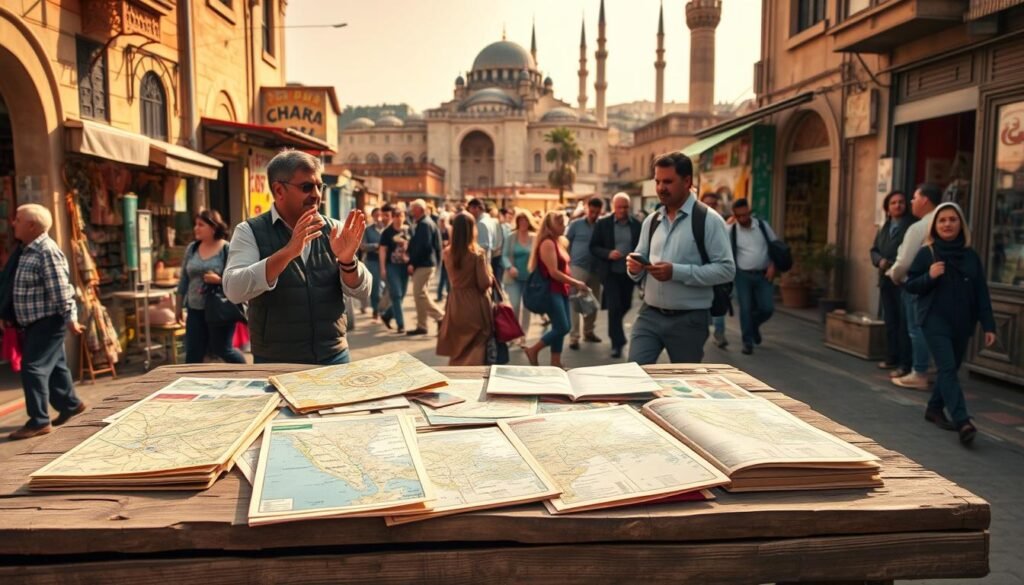
Mapping Your Route: A Sample One-Day Itinerary
Begin your day early to beat the crowds and heat. Start at the northern gates and work your way south through the main thoroughfare.
Morning hours work best for mosque visits before prayer times. Afternoons are perfect for market exploration and cafe breaks.
A well-planned route prevents backtracking and saves energy. You’ll cover more ground without feeling rushed.
Staying Hydrated and Finding Places to Eat
Cairo’s climate demands constant hydration. Carry a reusable water bottle and refill at restaurants.
Traditional cafes offer refreshing mint tea and fresh juices. These provide perfect opportunities to rest and people-watch.
Look for local eateries serving authentic Egyptian dishes. Many hidden gems offer delicious meals at reasonable prices.
Being Mindful of Cultural Customs and Prayer Times
Respect local traditions by dressing modestly throughout your visit. Shoulders and knees should remain covered.
Carry a scarf for mosque entries—women must cover their hair. Everyone removes shoes before entering prayer areas.
Avoid visiting mosques during the five daily prayer times. Friday midday prayers are particularly important to respect.
“The most rewarding visits combine careful planning with spontaneous discovery—knowing where you’re going while remaining open to unexpected moments.”
| Preparation Area | Essential Items | Practical Considerations |
|---|---|---|
| Navigation | Pre-planned route map | Avoid looking lost in crowded areas |
| Footwear | Comfortable walking shoes | Essential for uneven surfaces and long distances |
| Hydration | Water bottle and local currency | Small bills for drinks and snacks |
| Cultural Respect | Scarf and modest clothing | Required for mosque entry and general respect |
| Emergency Contact | Local tour company numbers | +43 660 9081449 or +201080733101 for assistance |
Carry small denomination Egyptian pounds for entrance fees and tips. 5, 10, and 20 LE notes work best for most situations.
Keep cameras discreet to avoid standing out as a tourist. Be aware of your surroundings while enjoying the incredible atmosphere.
Remember that Black Camel Tours remains available for last-minute guidance. Their local experts can provide assistance if needed.
This approach ensures your independent visit remains smooth and enjoyable. You’ll create memories while respecting the local culture.
Capturing the Perfect Photos of Old Cairo
Want to bring home stunning images that truly capture this magical place? Photography here offers incredible opportunities at every turn.
The right approach combines technical skill with cultural sensitivity. You’ll create beautiful memories while respecting local traditions.
Best Spots for Architectural and Street Photography
Islamic architecture provides endless photographic inspiration. Look for intricate details in mosques and madrasas.
Carved stone patterns and wooden screens make beautiful close-up shots. These elements showcase incredible craftsmanship.
Khan el-Khalili’s vibrant street scenes offer dynamic compositions. Capture the market’s energy and colorful displays.
Elevated positions provide breathtaking panoramic views. The Citadel and Al-Azhar Park overlook the historic skyline.
Key photographic opportunities include:
- Ornate minarets against the blue sky
- Sunlight filtering through carved window screens
- Shadow patterns on ancient stone walls
- Market vendors with their colorful wares
- Silhouettes against dramatic evening skies
Early morning light creates soft, beautiful illumination. Late afternoon offers warm golden tones and long shadows.
These times also mean fewer people in your shots. You’ll capture cleaner compositions of the beautiful landmarks.
Being Respectful When Taking Pictures of People
Always ask permission before photographing local residents. A simple gesture and smile usually communicate your request.
Respect any refusal without question. Some people prefer not to be photographed for personal or cultural reasons.
Avoid using cameras during mosque prayer times. This respects worshippers’ privacy and spiritual practice.
Never photograph military sites or personnel. This includes police stations and government buildings.
Be aware of your surroundings while focusing on shots. Don’t block pathways or disrupt daily activities.
“The best travel photographs balance technical excellence with ethical consideration—beautiful images that honor both subject and setting.”
The changing light creates different moods throughout the day. Morning offers clear, crisp images with soft shadows.
Evening brings warm golden light and dramatic silhouettes. Overcast days provide even lighting for architectural details.
Each condition offers unique photographic possibilities. Experiment with different times for varied results.
Your photographs will become treasured memories of this special place. They’ll tell the story of your journey through this historic area.
Making the Most of Your Trip: Extended Stays and deeper Dives
Have you thought about turning your quick visit into a truly immersive cultural journey? The incredible density of historical treasures here deserves more than a rushed day trip.
This remarkable district spans over 5 square kilometers of continuous history. You’ll find yourself wanting to linger longer at each fascinating site.
Why You Might Need More Than One Day
The sheer scale of Islamic Cairo makes extended exploration essential. With 5.23 square kilometers of historical sites, you’ll want 2-3 days for proper appreciation.
Different architectural styles and historical periods reveal themselves gradually. Rushing means missing subtle details and deeper understanding.
Multiple days allow you to experience sites at different times. Morning light reveals different aspects than evening atmosphere.
You’ll have time for spontaneous discoveries beyond the main landmarks. Hidden courtyards and local interactions enrich your experience.
Combining Your Visit with Other Cairo Attractions
Your historical journey can beautifully complement other Cairo highlights. The Egyptian Museum’s pharaonic treasures create fascinating context.
The Pyramids of Giza and Sphinx offer ancient wonders just outside the city. These iconic sites complete Egypt’s historical narrative.
Nile River cruises provide stunning perspectives of Cairo’s skyline. Dinner boats offer romantic evening views of illuminated minarets.
Modern districts contrast beautifully with historical areas. Exploring both helps you understand the city’s full character.
“The most rewarding visits balance deep historical exploration with broader cultural context—seeing both ancient wonders and modern life.”
Special events and festivals might enhance your visit during certain times. Local celebrations offer unique cultural immersion opportunities.
For comprehensive itinerary planning, consider Black Camel Tours’ extended packages. They create personalized experiences that maximize your time.
Contact them at Booking@blackcameltours.com or visit blackcameltours.com. Their expertise ensures you see the best of everything this amazing city offers.
Conclusion: Embarking on Your Unforgettable Cairo Adventure
Your journey through this remarkable district offers a unique experience blending ancient traditions with living culture. You’ll discover incredible architectural wonders and vibrant local life.
This area presents a fascinating blend of spiritual heritage and historical depth. Every corner reveals centuries of continuous civilization and cultural exchange.
Whether exploring independently or with professional guides, proper planning enhances your visit. Respectful behavior ensures meaningful interactions with local communities.
Carry home memories of breathtaking minarets, ancient churches, and bustling markets. This destination deserves multiple visits to fully appreciate its treasures.
For your next adventure, contact Black Camel Tours at Booking@blackcameltours.com or call +43 660 9081449 / +201080733101. Visit blackcameltours.com for personalized tour options.


